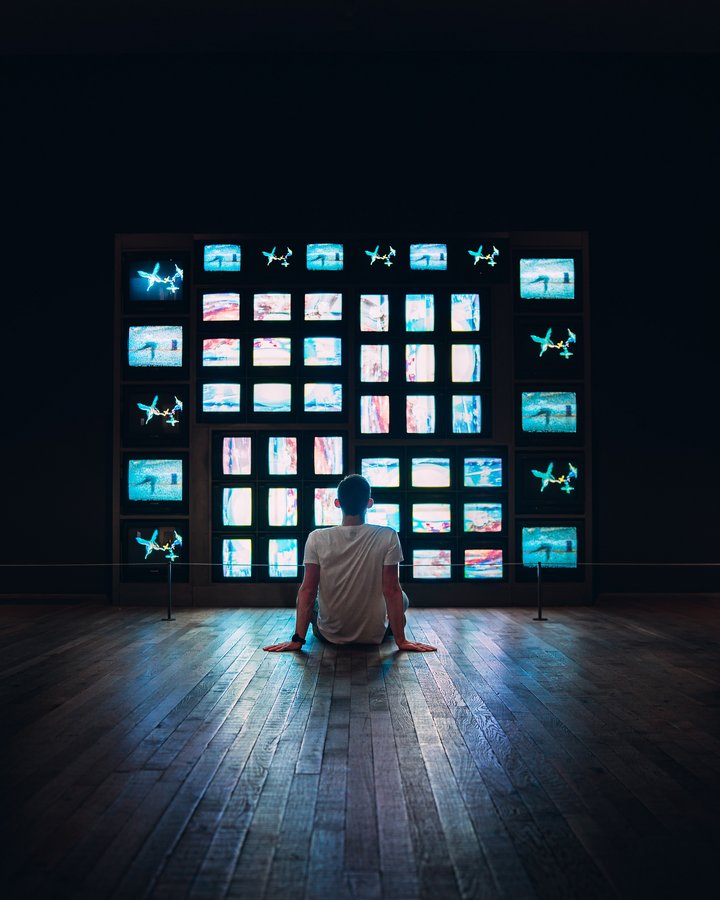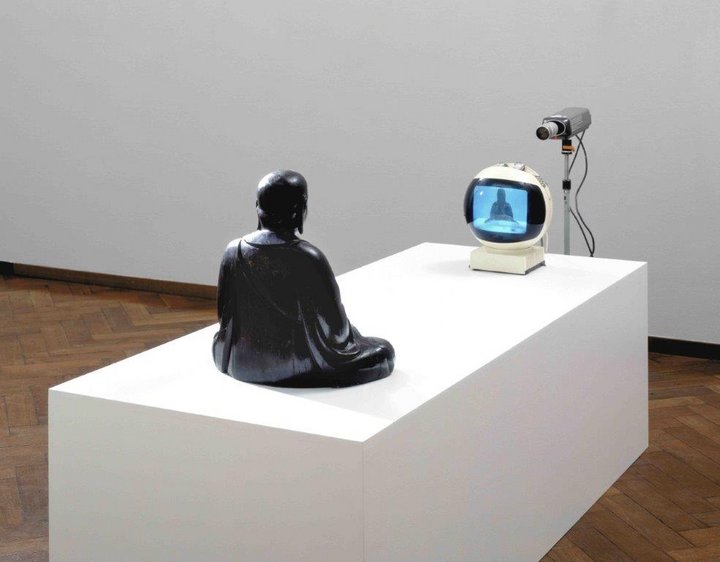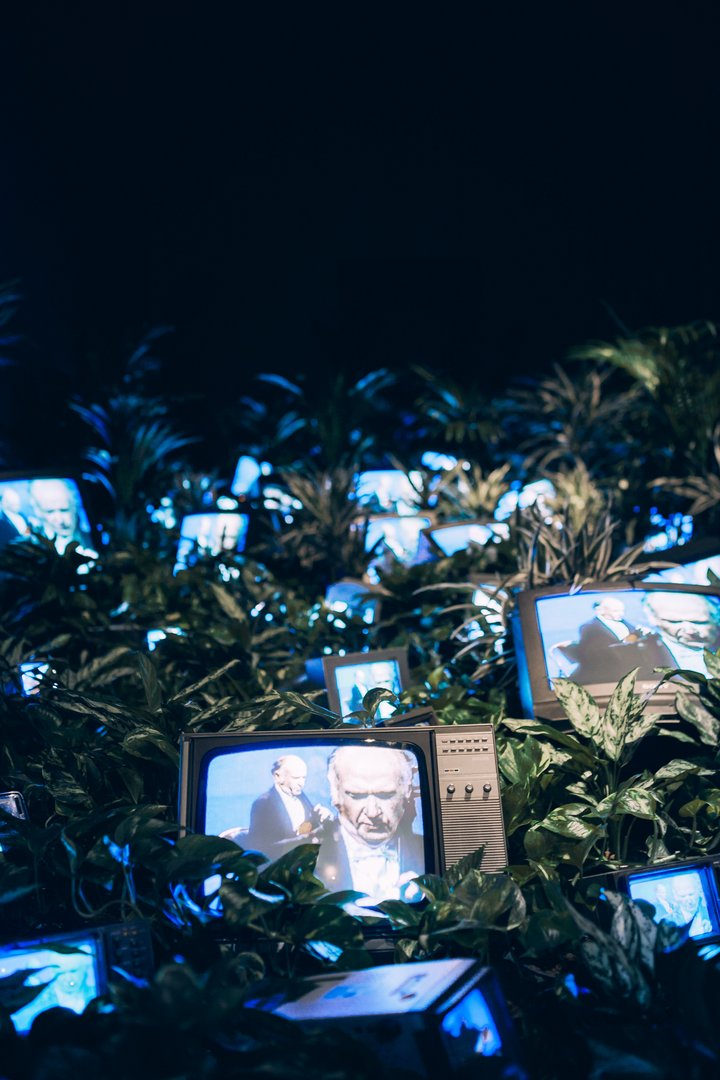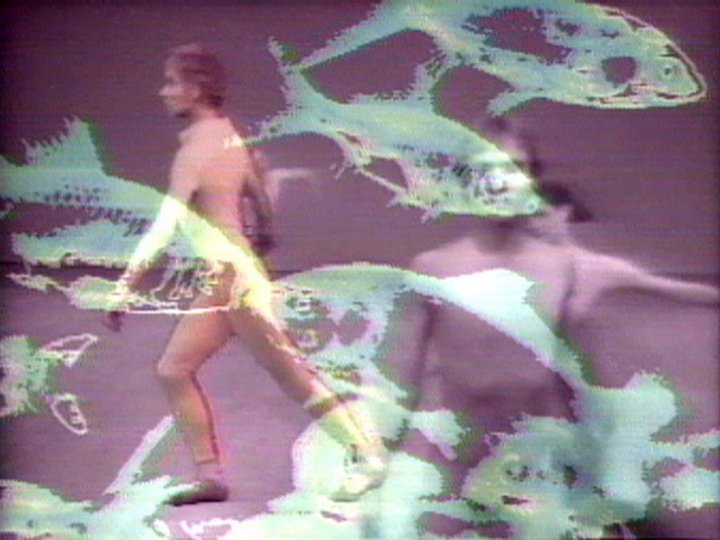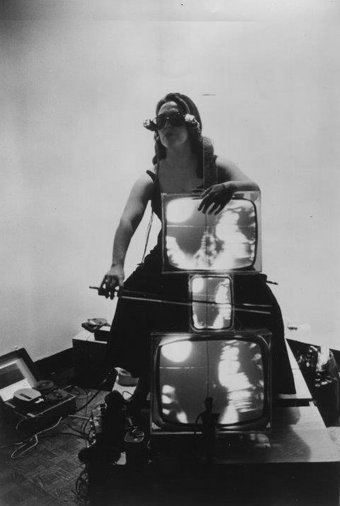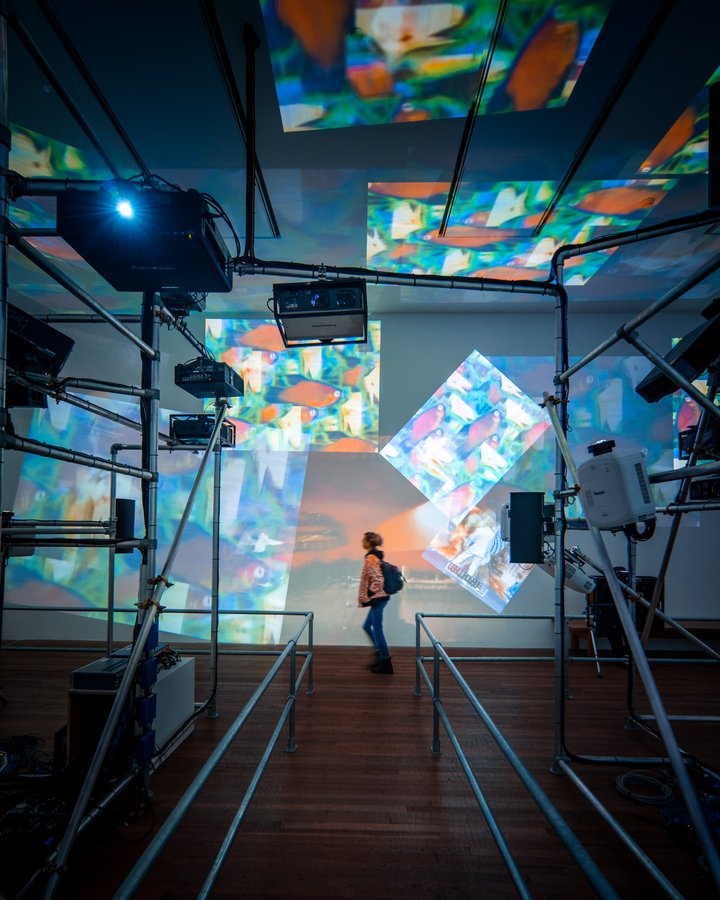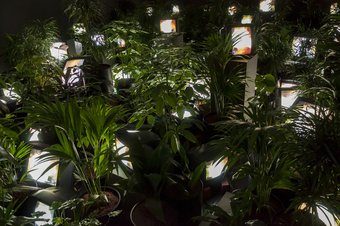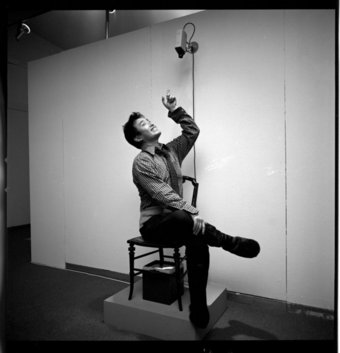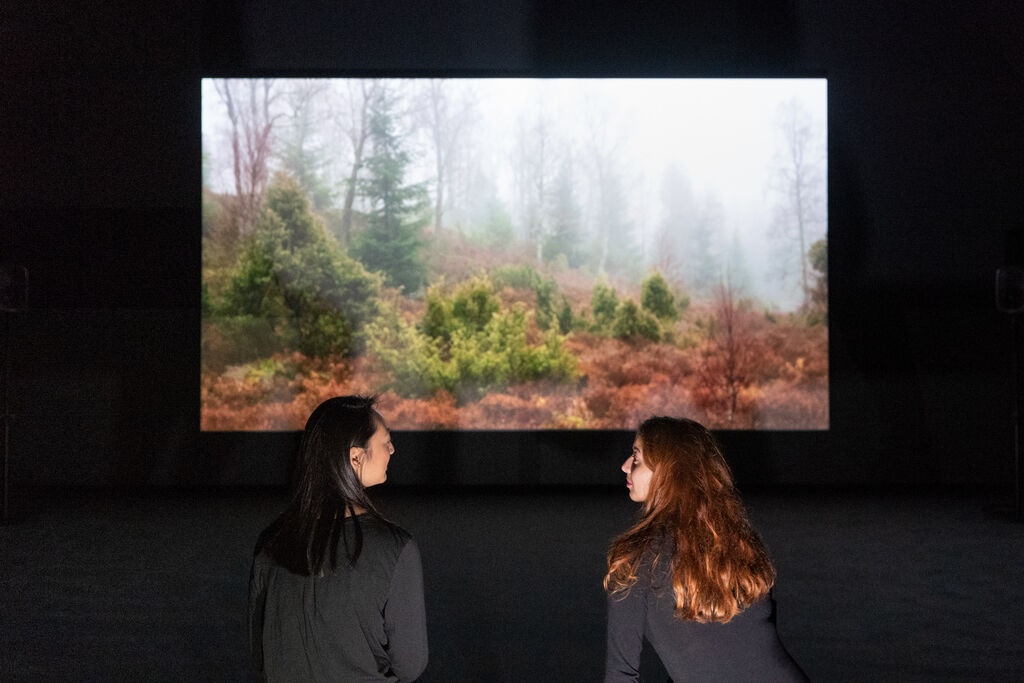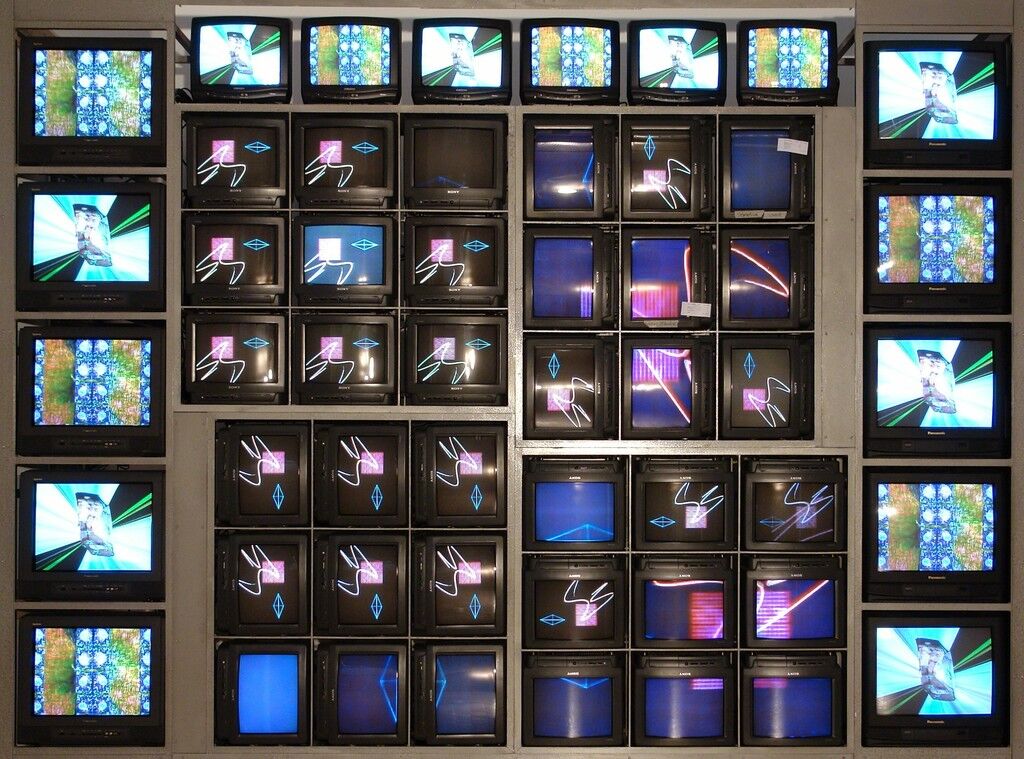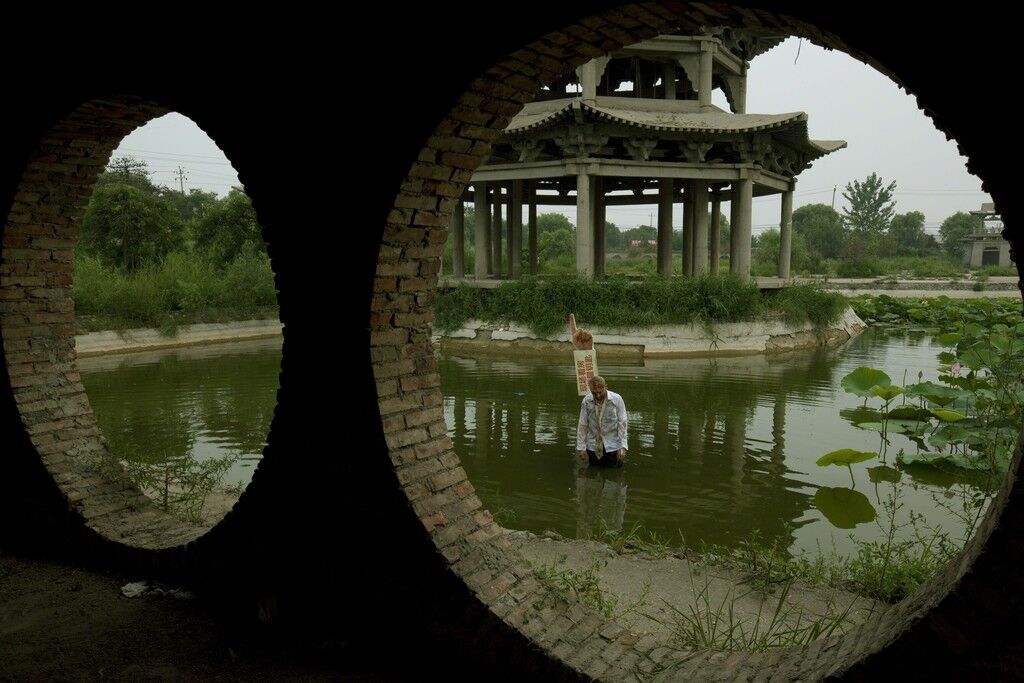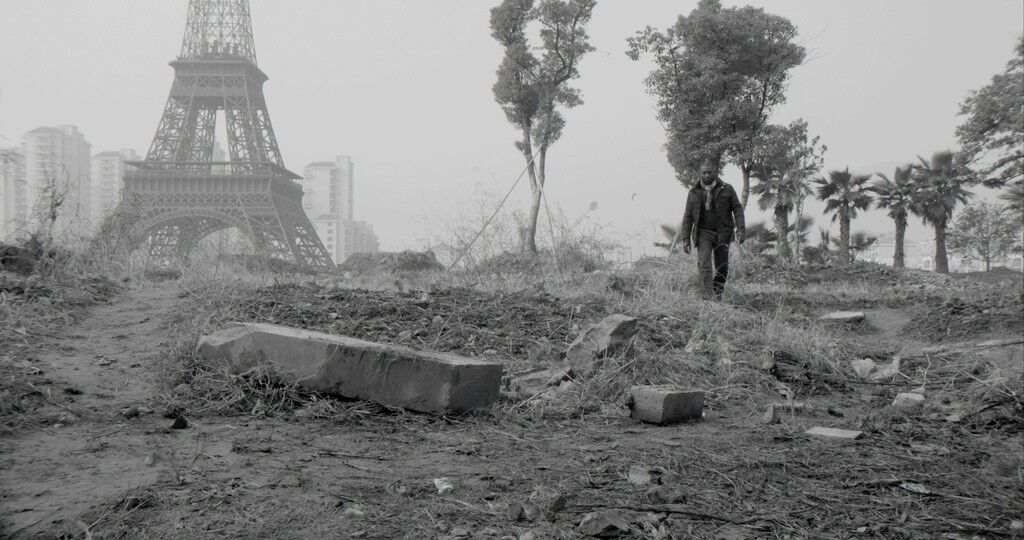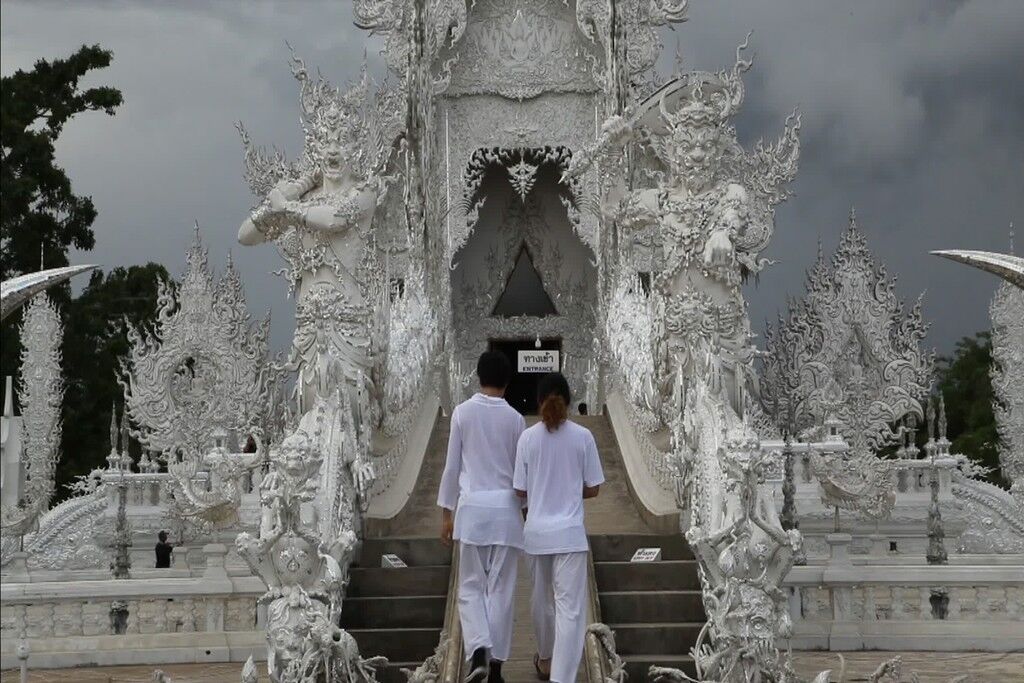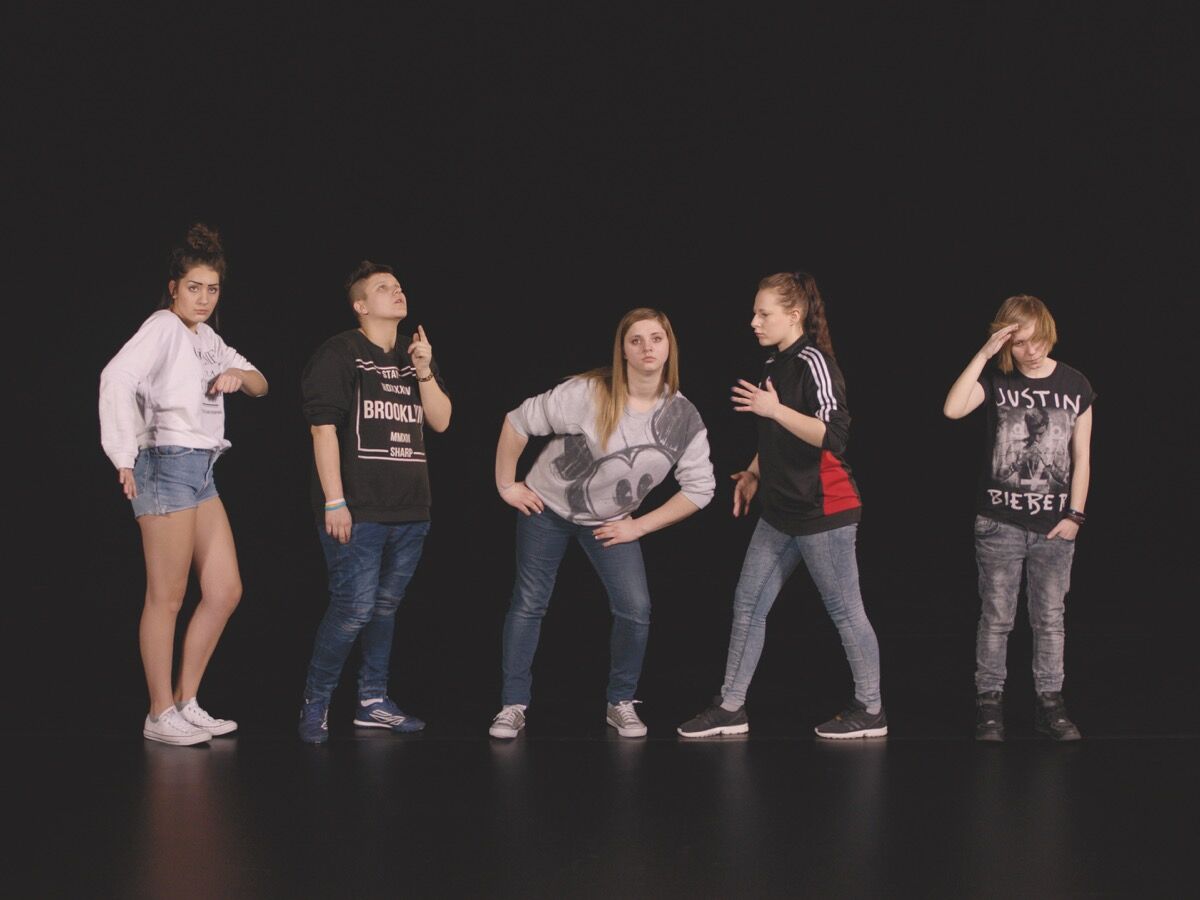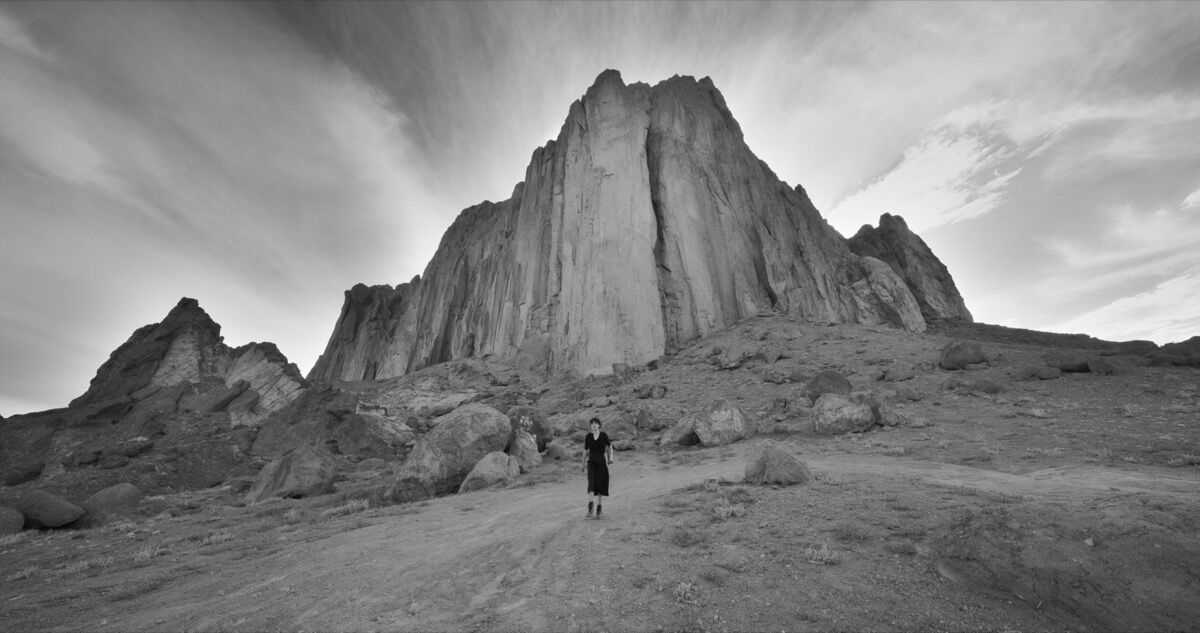Nam June Paik
Find out more about our exhibition at Tate Modern
Nam June Paik TV Eyeglasses 1971 Collection & © The Estate of Nam June Paik Photo: Tate
INTRODUCTION
Nam June Paik (1932–2006) played a leading role in bridging the gap between art and technology. Always innovative, his work encompassed a variety of artistic genres, from sculpture and performance to music and live broadcasting. A frequent collaborator, he worked internationally with artists, performers and specialists from different disciplines. This exhibition traces his career across five decades, including early musical scores, videos, altered TVs, robots and large-scale installations.
Paik was born in Seoul, Korea (now South Korea) but lived and worked in Japan, Germany and the United States. His travels led him to question national borders and cultural differences in an increasingly connected world. His art reflects a fascination with the philosophies and traditions of both Eastern and Western cultures.
Nam June Paik TV Buddha 1974 Stedelijk Museum, Amsterdam © The Estate of Nam June Paik
This room introduces some of Paik’s key themes and methods. Hand and Face 1961 uses his own body as the source and subject of performative actions. In TV Buddha 1974, a sculpture of Buddha gazes into its own image, relayed through a closed-circuit television system. Paik’s lifelong exploration of Zen Buddhism and the meaning of meditation are also seen in One Candle (Candle TV) 2004.
TV GARDEN
Nam June Paik TV Garden 1974-7 (2002) Kunstsammlung Nordrhein-Westfalen (Düsseldorf, Germany) © Estate of Nam June Paik Photo: Tate
With TV Garden 1974–77, Paik imagined a future landscape where technology is an integral part of the natural world. Placing TV sets alongside live plants, he creates an environment in which the seemingly distinct realms of electronics and nature coexist. His approach follows the Buddhist belief that all things are interdependent and closely connected. It also suggests that technology is not in conflict with nature but an extension of the human realm.
The TV sets display Paik’s Global Groove 1973. This colourful, fast-paced video mixes high and popular cultures, with imagery from traditional and contemporary, Western and non-Western sources. It captures the disparate and sometimes overwhelming content of contemporary mass media. From Beethoven’s Moonlight Sonata and chants by the Beat poet Allen Ginsberg to Nigerian dance performance and Japanese commercials, Paik’s selection is as diverse as any TV channel but perhaps not as predictable.
EXPOSITION OF MUSIC - ELECTRONIC TELEVISION
Paik studied the history of classical music at the University of Tokyo. He moved to Germany in 1956 to pursue his interest in experimental composition. Here he met avant-garde composers such as Karlheinz Stockhausen and John Cage. Their radical approach to performance, improvisation and their introduction of elements of chance into the process of composition had a huge influence on Paik’s work.
In 1963 Paik had a solo exhibition in Wuppertal, Germany, entitled ‘Exposition of Music – Electronic Television’. Three storeys of a villa converted into a gallery were filled with immersive environments and sculptures that invited the active participation of the audience. There were musical instruments made or modified by the artist, including three customised pianos and Zen for Wind 1963, an array of dangling objects playing random noises as they moved and rattled. In the basement visitors could create their own compositions by reproducing snippets of music using modified record and tape players. As an impromptu action, artist Joseph Beuys (a friend of Paik) destroyed one of Paik’s pianos. Paik liked this anarchic gesture and left the broken remnants on display.
One room was dedicated to Paik’s manipulated television sets. In Foot Switch Experiment 1963, the image on screen could be altered in real time. Other televisions, such as Zen for TV 1963, were displayed in a broken state.
EXPERIMENTS
In the early 1960s Paik began to experiment with TV sets and other audio-visual equipment. Many of his works demonstrate how TVs could be turned against themselves, using magnets to distort their images and reveal their manipulative power. Paik recognised the importance of the mass media and believed that artists could help steer video and other electronic technologies to become more democratic instruments for cultural transmission.
His use of robots similarly reflected a desire to make technology appear closer to humanity, rather than the product of complex and hidden scientific processes. The radio-controlled Robot-K456 1964 was designed as an intentionally shoddy humanoid figure that could walk, play recorded sounds and even urinate.
Paik’s visionary projects often required access to expensive technology. He would contact companies with high-tech laboratories, asking them to collaborate on ‘electronic art experiments’. In 1969, as artist-in-residence at the Boston TV station WGBH-TV, Paik built an analogue ‘video synthesizer’ in collaboration with engineer Shuya Abe. It could apply effects such as distorting, colourising and superimposing to video images in real time, using several sources simultaneously.
JOHN CAGE AND MERCE CUNNINGHAM
Paik met the experimental composer John Cage in 1958 in Darmstadt, Germany. Cage was such a significant influence on his work that Paik described the year 1957 as ‘1 BC (Before Cage).’ Cage inspired Paik to incorporate chance and silence into his work. Their conversations also deepened Cage’s interest in Zen Buddhism and other East Asian philosophies.
Cage’s 4’ 33” 1952 – a piece of music in which the musicians remain silent – gave Paik the idea for his Zen for Film 1964. This blank 16mm film explored themes of emptiness, boredom and random interference. Dust and scratches on the film, and incidental events such as the shadows cast by the spectators, became part of the work.
Nam June Paik Merce by Merce by Paik: Part Two: Merce and Marcel 1978 Courtesy of Electronic Arts Intermix (EAI), New York and the Estate of Nam June Paik © The Estate of Nam June Paik
Another long-time friend and collaborator was the choreographer Merce Cunningham. Merce by Merce by Paik was Paik’s two-part video tribute to him, involving or referencing a wide network of friends and artists. Film-maker Charles Atlas worked with Paik on Part One: Blue Studio: Five Segments 1975–6. Cunningham performed a choreography created especially for the video. For Part Two: Merce and Marcel 1978, Paik and artist Shigeko Kubota mixed images of Cunningham, artist Marcel Duchamp and other footage to question the relationship between art and everyday life.
SELF-REFLECTION
This room presents artworks and objects from Paik’s studio that shed light on his diverse interests. It includes his address book, notebooks, Casio keyboard, toy TVs and robots. There are publications with articles about his own work and about his colleagues, and reference books that he used.
Paik experimented with many different creative processes and artistic media, often including fragments of personal stories in his work. Egomachine 1974 is a playful work that highlights an artist’s ego. The title of July 20 1985 is Paik’s birthday. It shows historic moments from the same date as well as cryptic diagrams.
Paik also made works that question the traditional media of painting. Untitled 1974, 1982–3 combines the physical elements of a painting such as a frame and canvas with an empty TV casing. His later TV sculptures, such as Self-Portrait 2005, often incorporate drawings and text in oil markers or paints.
TRANSMISSION
Paik wanted to use telecommunication technologies to distribute art and enable long-distance live collaborations. In the late 1960s, as artist-in-residence at Boston’s public television station WGBH-TV, Paik developed some of the earliest examples of video art made for broadcast TV. Video Commune (Beatles Beginning to End) 1970 was an improvised collage of distorted TV imagery. It was composed using the Paik-Abe Video Synthesizer and accompanied by the Beatles’ songs. Paik invited passers-by into the studio and let them ‘remix’ video images as they aired.
Paik saw satellite transmissions as the perfect tool for his art to cross geographical boundaries. Aired on 1 January 1984, Good Morning, Mr. Orwell connected live events in New York and Paris. It was also broadcast in Korea, the Netherlands and West Germany.
Paik’s next satellite project, Bye Bye Kipling 1986, linked New York, Seoul and Tokyo during the Asian Games. Wrap Around the World 1988 similarly connected Korea, the USA, Brazil, Austria, Germany, Ireland, Israel, Japan, Italy, China, the UK and the USSR.
In 1974, Paik coined the phrase ‘Electronic Superhighway’ to refer to a decentralised, world-wide system for exchanging information. His 1993 video wall Internet Dream refers to his prediction of a global information network.
FLUXUS
Formed in the early 1960s, Fluxus was an international collective of radically experimental artists. Its founder George Maciunas took notice of Paik’s performances and immediately recruited him as a member. As a frequent traveller between Europe, the USA and Japan, Paik played an important role in drawing together artists, composers and performers from across the world.
The ideas of Fluxus suited the undefined, playful and boundary-crossing character of Paik’s work. Fluxus artists often used scores and written instructions to generate anarchic live performances. Any situation or gesture, no matter how mundane, could turn into a Fluxus event. Any material or object could be made into an artwork. Cheap and portable, Fluxus works often took the form of publications, newspapers, multiples and mail art projects.
Fiercely independent and disruptive, Paik sometimes went against the wishes of Maciunas and was temporarily ‘expelled’ from Fluxus. In 1964 he was marked as a ‘traitor’ for taking part in Stockhausen’s experimental musical drama Originale, which was being boycotted by Maciunas. However, Paik continued to make Fluxus-inspired works throughout his career. His admiration for Maciunas and his Fluxus spirit never wavered.
CHARLOTTE MOORMAN
Paik and the cellist Charlotte Moorman worked together for almost thirty years. They shared a common interest in avant-garde music and in staging energetic liveperformances. Both artists believed that sexuality was unjustly excluded from classical music, and many of their performances involved Moorman playing the cello in various states of undress.
Known as the ‘topless cellist’, Moorman was arrested for indecent exposure during a 1967 performance in New York. Paik responded by building a series of television sculptures, such as TV Bra for Living Sculpture 1969, TV Cello 1971 and TV Eyeglasses 1971, which she could use as costumes and props. Paik saw this as another opportunity to show that humanity could coexist and even partially merge with technology.
Anti-militarism was another joint interest. For the video Guadalcanal Requiem 1977–9, Paik and Moorman confronted the trauma of war through a joint performance on the South Pacific island of Guadalcanal, the site of a brutal battle in the Second World War.
Moorman’s life was cut short by cancer in 1991. Paik made several works dedicated to his friend and collaborator, including the poignant Room for Charlotte Moorman 1993.
JOSEPH BEUYS
Having first met at the Zero group exhibition in Düsseldorf in 1961, Paik and Joseph Beuys maintained their artistic and personal friendship throughout their careers. This room brings together some of their collaborative projects, including Documenta 6 Satellite Telecast 1977, In Memoriam George Maciunas 1978 and Coyote III 1984.
Paik and Beuys had many shared experience and interests. Their countries, Germany and Korea, were both divided by the Cold War. Both artists were drawn to similar images such as the moon, rabbits and shamanistic symbols. They both wanted to unite Europe and Asia, man and nature, and the scientific and the spiritual in their work.
While Beuys became increasingly active in the political sphere, Paik remained non-political and sought answers in technology, information and communication.
ONE CANDLE (CANDLE PROJECTION)
In One Candle (Candle Projection) 1989, a CCTV camera is pointed at a single flickering flame. The image is repeated multiple times on the walls by video projectors. Like One Candle (Candle TV) in Room One, this work presents the electronic image as a light source, but also reflects on the precarious nature of existence.
Some of the projections are separated into red, green and blue light. These are the basic components of the video image, emphasising that video is an illusory form of representation. At the same time the air flow generated by visitors’ movements alters the shape of the flame. The live candle demonstrates, in real time, the Buddhist belief that all things are interconnected and in a continual process of change. Bringing together technology and the principles of Zen Buddhism, this meditative work embodies some of Paik’s deepest concerns.
SISTINE CHAPEL
Photo: Tate
In 1993 Paik and German artist Hans Haacke were invited to jointly represent Germany at the Venice Biennale. Both artists had lived in the United States since the mid-1960s. Paik exhibited a series of works inspired by Marco Polo’s thirteenth-century journey from Venice to Mongolia and beyond. He used the subject to explore the historical and philosophical links between Europe and Asia. The Mongolian Tent (shown in Room 10) was also shown in the German Pavilion, which received the Golden Lion award that year.
Another key work from Paik’s Venice Biennale exhibition was Sistine Chapel 1993, presented here for the first time since 1993. This immersive video installation filled one of the wing spaces of the pavilion, including the ceiling. It originally used 42 projectors which switched at random between four separate videos, all playing at the same time. An audio-visual collage of new footage and samples from Paik’s past videos, it featured many of the friends, collaborators and public figures seen in this exhibition. It was Paik’s own way of summarising his artistic career with video.

